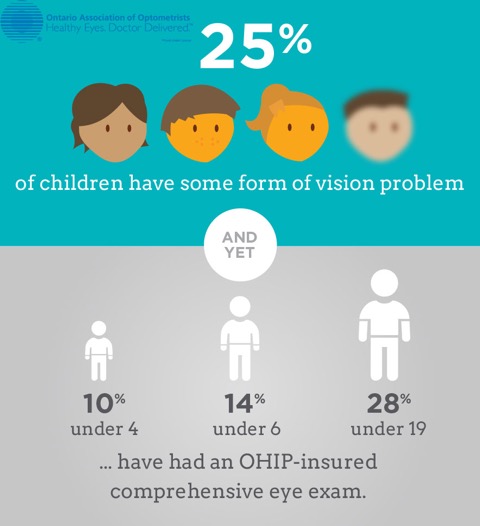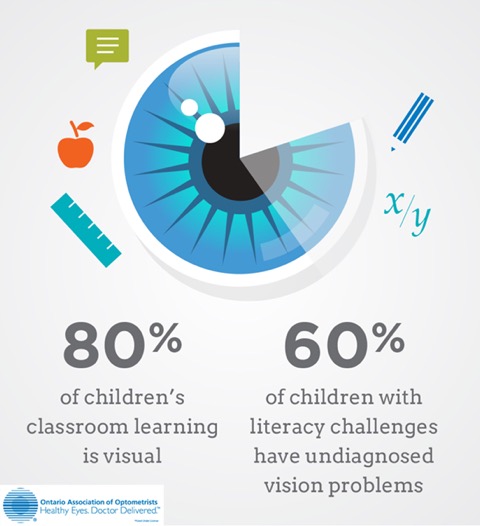|
Back-to-school is often a hectic time for most parents as they scramble to check everything off their to-do lists. But even though vision is key to a child's success at school, many parents forget to include eye exams in their late-summer prep. If you're one of these parents, it's important to get your little scholar's eyes checked as 25 per cent of school-aged children have a vision problem according to the Canadian Association of Optometry. “Children easily adjust to their surroundings and often don't realize they cannot see clearly because they assume everyone sees the same way they do,” explains Amber Fournier, registered optician. “Over three-quarters of visual learning happens in the first 12 years of a child's life, so back-to-school is the perfect time for parents to book an eye exam for their child. It's important that kids are able to see the chalkboard and any print and online materials to help them succeed in the classroom.” Experts recommend that school-aged children receive an eye exam once a year. Most provincial health programs cover the cost of an annual exam for children up to 18. A regular eye exam can be the difference between success and failure for a child, and can even help explain learning difficulties. For example, 60 per cent of learning disabilities are thought to stem from undiagnosed eye problems, and 60 per cent of children with reading difficulties may have an undiagnosed vision problem. www.newscanada.com Dr. Kar Sakhichand earned his Doctor of Optometry degree in 1995 at the University of Waterloo, School of Optometry and Vision Science. With over 20 years of experience, Dr. Sakhichand’s career and experience have encompassed many facets of optometry, but he is most proud to have provided comprehensive eye care to families in Aurora, Newmarket and surrounding communities since 2003.
The Ontario Association of Optometrists recommends annual eye examinations for school-aged children. Children's eye examinations are covered by OHIP once per year.
A survey conducted by Leger Marketing on Children's Eye Health in July 2010, reported that 61 per cent of Canadian parents mistakenly believe they would know if their child was having difficulty with their eyesight. However, many serious eye conditions do not have obvious symptoms and some eye diseases only show symptoms when the condition is advanced and difficult to treat. Conditions such as amblyopia or a “lazy eye” need to be addressed when a child is young. Comprehensive eye examinations would result in 51% more children receiving successful treatment for amblyopia by age 10.
As indicated by the Canadian Association of Optometrists evidence based Frequency Guidelines published in Primary Health Care in 2012, Doctors of Optometry recommend infants have their first eye examination between six and nine months of age. Children should have at least one eye exam between the ages of two and five, and yearly after starting school to ensure optimal vision and development. It is estimated that only 14% of Canadian children under the age of six have had eye exams from a Doctor of Optometry. Fortunately, according to Leger Marketing these numbers are improving but still half of children under the age of four have never seen an optometrist. CAO recommends that a thorough eye examination include:
Vision and Learning It has been shown that 80% of all learning during a child's first 12 years is visually based, therefore a comprehensive eye examination is essential to provide the full assurance of vision and eye health that a simple eye-chart test or a vision screening cannot. In some provinces, schools offer vision screening programs that many parents and teachers misconstrue as a comprehensive eye exam. It is important to recognize that vision screening is a limited procedure, not equivalent to an optometric eye exam. Studies have shown that approximately 43 per cent of children with vision problems can pass a vision screening test. While vision screening tests the ability to see clearly at a distance, a comprehensive eye exam looks at all aspects of a child’s vision function, including how well the eyes focus up close, how the eyes work together and the overall health of the eyes. Even if your child has 20/20 vision, they still need to have an eye exam. Report cards in Ontario were re-formatted in recent years to emphasize the importance of how students work and how this contributes to their overall academic success. As parents and teachers review each child's progress they may want to consider whether vision problems might be a contributing factor to performance and behaviour in class.
Students are evaluated on learning skills and work habits, self regulation, collaboration, responsibility, organization, independent work and initiative in addition to academics. Optometrists recognize that vision skills contribute to the development of these learning tools. In fact, more than 80% of learning is done through the eyes. Therefore, assessment of a child's individual learning strategies can reveal signs of vision problems that influence his/her learning potential and engagement in school. "Children younger than 12 years of age often do not have the awareness or communication skills to recognize that they have a vision problem," says Dr Catherine Chiarelli, a Toronto-area optometrist. "Students may have to work extra hard to overcome vision problems for periods of time but eventually may become distracted or give up on a task as the eyes become tired or strained. This might translate into a child seeming unwilling to work well independently or having poor work habits." Observation of some specific features of a child's learning style may reveal potential vision problems. These include:
Ontario schools now ask students to participate in interviews to review their accomplishments and identify areas for improvement. Parents and educators can help children who are experiencing difficulties by raising awareness of the signs and symptoms vision problems, both by asking children specific questions about vision and by observing their visual behaviours at school and at home. One in six children has a vision problem significant enough to impair his/her ability to learn. Common visual conditions in school-aged children include refractive error (nearsightedness, farsightedness, astigmatism) which causes blurred vision, and eye co-ordination deficiency causing visual discomfort, headaches, double vision, reduced tracking and eye-hand co-ordination and/or headaches. The Ontario Association of Optometrists recommends annual eye examinations for school-aged children. Children's eye examinations are covered by OHIP once per year. |
Joe BusharaWith over 30 years experience licensed optician Joe Bushara and his highly experienced team, bring you the latest trends in frames and technologies in lenses from around the world. Categories
All
Archives
March 2024
|




 RSS Feed
RSS Feed
